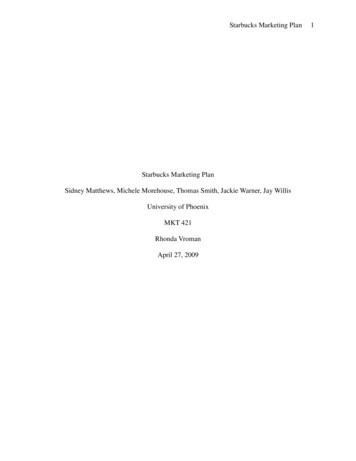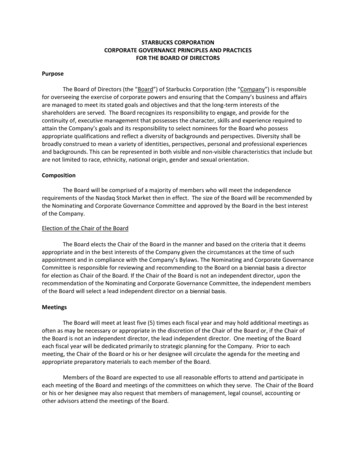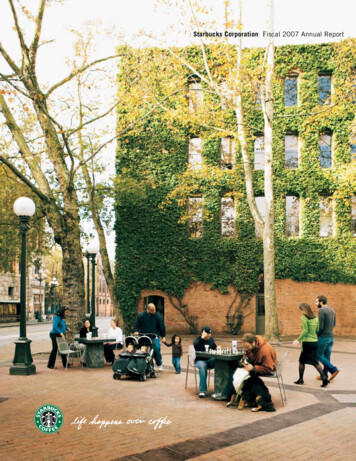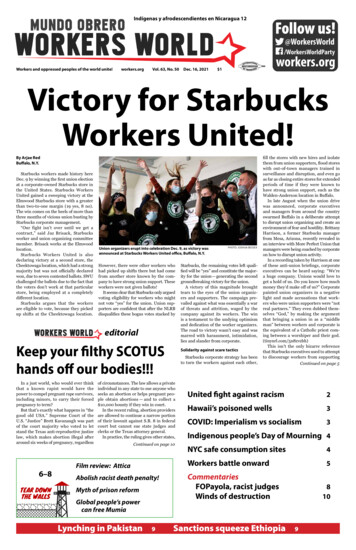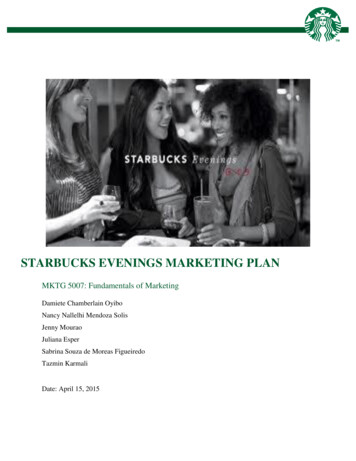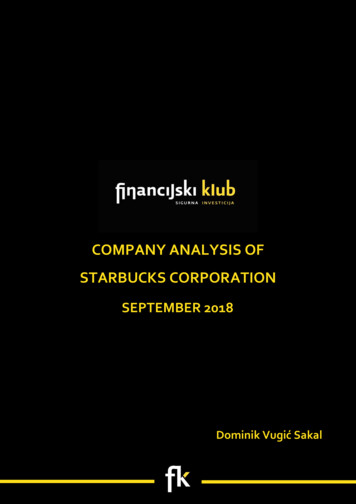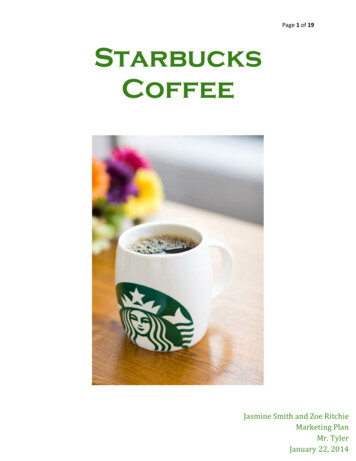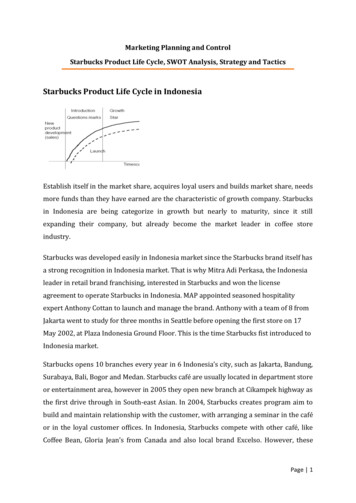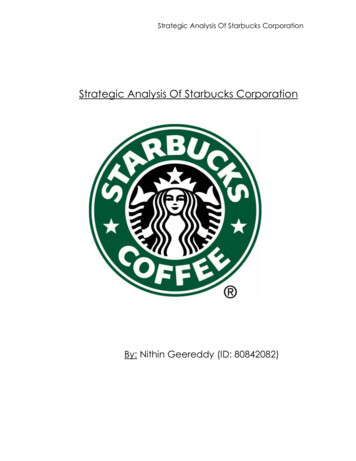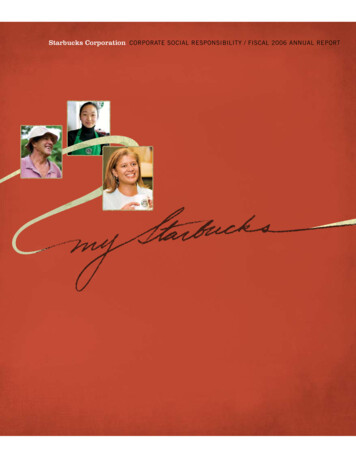
Transcription
Starbucks Corporation Corporate SoCial reSponSibility / FiSCal 2006 annUal report
Maybe you have a Starbucks you callyour own. And because it is yours,you expect a lot from it.Customers want to feel good about the place theygo and the coffee they drink. Our employees,whom we call partners, want to feel proud whentalking to friends and family about where theywork. Farmers want to know that they candepend on us for a livelihood that’s sustainable.We have come to appreciate that throughout theworld many people feel a sense of connection tous. Being their Starbucks is an honor. And also aresponsibility.For us corporate social responsibility is not just aprogram or a donation or a press release. It’s theway we do business every day.This report is one of the ways we openly andhumbly share our commitment to do businessresponsibly. To continue to earn the privilege ofbeing your Starbucks.STARBUCKS MIS SIO N STATEMENT ANDGUIDIN G PRIN CIPLE STo establish Starbucks as the premier purveyor of the finestcoffee in the world while maintaining our uncompromisingprinciples as we grow.The following six Guiding Principles will help us measure theappropriateness of our decisions: Provide a great work environment and treat eachother with respect and dignity. Embrace diversity as an essential component in theway we do business. Apply the highest standards of excellence to thepurchasing, roasting and fresh delivery of our coffee. Develop enthusiastically satisfied customers all ofthe time. Contribute positively to our communities and ourenvironment. Recognize that profitability is essential to ourfuture success.S TA R B U C K S A N D C O R P O R AT E S O C I A L R E S P O N S I B I L I T Y
Dear Stakeholders,We are often asked how Starbucks went from a single coffee shop in 1971 to one of the mostrecognizable and respected global brands today. Delivering great coffee, exceptional service andan uplifting and personal customer experience have all contributed to Starbucks success. Equallyimportant has been our commitment to conducting business in a socially and environmentallyresponsible manner, a commitment that stems from Starbucks Mission Statement andGuiding Principles.Our store partners (employees) are connecting and creating relationships with our customersevery day. We believe it matters greatly that they feel Starbucks is a great place to work, and acompany that cares not only about their well-being but also about the world we live in. Goodcommunication is key to all of this and helps to inspire our partners about the company theywork for, the important role they play at Starbucks and the customers they serve. With more than145,000 partners worldwide, our ability to communicate effectively and passionately about whatStarbucks is doing to be a good company – in both a personal yet focused manner – is absolutelyessential and a top priority for us.We believe the relationships we have with external stakeholders can be strengthened by focusingmuch of our communications on Starbucks commitment and passion to improve the world andthe ways in which we are demonstrating this. For instance, we want our customers, shareholders,communities and others to understand how we are working together with farmers and suppliers tohelp create a more sustainable approach to high-quality coffee production. We also want to sharewhat Starbucks is doing to contribute positively to local communities; minimize our environmentalfootprint; be responsive to our customers’ health and wellness needs; and how Starbucks is servingas a leader in both our industry and within our global society through our participation inorganizations such as the United Nations Global Compact.We were very mindful of taking a focused approach when we prepared this year’s CorporateSocial Responsibility Annual Report. Rather than attempt to address every issue in the abridgedprint version of our fiscal 2006 report, we conducted a materiality assessment to determine whattopics are of most significance to our stakeholders and to Starbucks, a process explained on thefollowing page.As you read through this full report we hope the information helps you assess for yourself how wellStarbucks is doing with regard to our corporate social responsibilities. As always, we encourage youto share your honest feedback. To do so, we have created an online survey which is described on theback page of this report.On behalf of everyone at Starbucks, thank you for taking your time to learn more about howStarbucks is doing business in a different kind of way.Sincerely,Howard SchultzchairmanJim Donaldpresident and chief executive officerS TA R B U C K S A N D C O R P O R AT E S O C I A L R E S P O N S I B I L I T Y
Focusing on MaterialityThis is Starbucks sixth annual Corporate Social Responsibility(CSR) Report. This year, we took a different approach bypublishing both a printed abridged version and this full reportonline. Media coverage and blog discussions of issues. Stakeholder feedback specific to Starbucks 2005 CSRReport. Global Reporting Initiative (GRI) recommended topicsand data for inclusion.We began our fiscal 2006 reporting process by conductinga materiality assessment to ensure that we are aligned withthe materiality principle of the Global Reporting Initiative(GRI) regarding content. Specifically, the topics and indicatorscovered in our CSR Report should reflect Starbucks significanteconomic, environmental and social impacts, or substantivelyinfluence the assessments and decisions of our stakeholders. Weconsulted a variety of sources – both internal and external – aspart of our materiality assessment. These sources included:After reviewing these sources, we compiled a list of issues andprioritized each one based on the following criteria: Company objectives, strategies, policies, programs andrisk factors. Partner (employee) surveys and other input gatheredthrough various feedback mechanisms. Customer contact feedback. Shareholder resolutions and anecdotal feedback.Based on our assessment, we determined that the materialissues of greatest importance to Starbucks and ourstakeholders, which the company has a reasonable levelof control over, fall into five topic areas highlighted in thetop right box below. We chose to focus our abridged printreport on these subjects only. This full report includes manyof the topics on the following matrix. Input gathered through stakeholder dialogues. Informal input from coffee suppliers.Contents in the web reportContents in the printed reportVerY iMportantCoffee purchasing practices Prices paid to coffee farmers and suppliers Respect for workers’ human rights Long-term availability of high-quality coffeeGrowth and expansion Impacts on local communitiesenvironmental impacts Climate change Energy consumption Paper cupshealth and wellness Products Nutrition informationworkplace practices Culture and benefits Satisfaction and engagementCoffee purchasing practices Organic and conservationiMportantsiGnifiCanCe to externaL stakehoLdersCoffee purchasing practices Fair Trade Certified coffee The importance of the issue to – and potential impacton – Starbucks. The importance of the issue to – and potential impacton – external stakeholders. The amount of reasonable control Starbucks has over aparticular issue.environmental practices Water usage Waste and recycling Sustainable packaging Transportation/distribution impactsdiversity Workplace Supplier CommunitiesCustomer Concerns rBGH dairy Marketing to youth CaffeineGovernance Executive compensation Majority voting forboard members Transparencystakeholder engagementLocal Community engagement Charitable giving Partnerships Partner (employee)volunteerismsustainable sourcing Supplier Code of Conduct Human rights/working conditions Tea Paper Ethos waterresponsible Marketing Starbucks LiqueursiMportantCoffee purchasing practices Verification and transparency Access to credit Social investmentsenvironmental impacts Store design and operationsworkplace practices Training and development Right to organize Health and wellness Health and safetyManaging Corporate social responsibility Vision and priority setting Ethics and governanceCocoa sourcing practicespublic policyGlobal philanthropic programsVerY iMportantsiGnifiCanCe or potentiaL iMpaCt on starbuCksS TA R B U C K S A N D C O R P O R AT E S O C I A L R E S P O N S I B I L I T Y
About This ReportScopeThis report includes information on Starbucks U.S. andCanada company-operated retail and global supply chainoperations – the areas that represent the majority ofStarbucks social, environmental and economic impacts.Starbucks system for collecting and reporting reliable social,environmental and economic performance data does notencompass all of our operations. Where available, anecdotalinformation is included for international and licensed storeoperations. Information on total coffee purchases is for bothStarbucks Coffee Company and Seattle Coffee Company.Reporting YearStarbucks fiscal year 2006 (October 3, 2005–October 1, 2006), unless otherwise noted.CurrencyAll references to currency are in U.S. dollars, unlessotherwise noted.Starbucks 2006 CSR Report and Previous n IntegrityStarbucks management is responsible for the preparation andintegrity of the information in this report. Through a systemof internal controls, including a comprehensive verificationprocess involving internal subject matter experts, we believethis report fairly represents our CSR activities and results forthe fiscal year ended October 1, 2006. External verification isprovided by Moss Adams LLP. See page 76.Global Reporting InitiativeStarbucks reporting continues to be influenced by the GlobalReporting Initiative’s (GRI) 2002 Sustainability ReportingGuidelines in determining relevant content and performancemetrics to include. See the Table of Contents on the nextpage for a listing of GRI indictors included in this report,and page 13 for a description of how we applied the GRIprinciples. Information about GRI is online atwww.globalreporting.org.S TA R B U C K S A N D C O R P O R AT E S O C I A L R E S P O N S I B I L I T Y
CONTENTSPAGEGLOBAL REPORTINGINITIATIVE (GRI) INDICATORSSTARBUCKS AND CORPORATE SOCIAL RESPONSIBILITYStarbucks Mission Statement & Guiding PrinciplesLetter to StakeholdersFocusing on MaterialityAbout This ReportKey Performance Indicators Summary and Highlights for Fiscal 2006Starbucks Company ProfileIntegrating Corporate Social ResponsibilityExternal RecognitionUnited Nations Global Compact1234791014153.71.22.11-2.13, 2.20, 2.21EC4, EC10, EN17, LA7, LA112.1-2.3, 2.8, 2.16, EC12.9, 3.1-3.3, 3.6, 3.8, 3.10-3.12, LA11SO43.14PRODUCTSOur World of ProductsSustaining Coffee QualityCreating a Sustainable ApproachC.A.F.E. PracticesThe Link Between Quality and PriceRespect for Workers’ Human RightsC.A.F.E. Practices – Hitting Our TargetsC.A.F.E. Practices – Findings and Next StepsC.A.F.E. Practices – The Verification ProcessEconomic TransparencyStarbucks and Fair TradePurchasing Certified Organic and Conservation CoffeesAccess to CreditInvestments in Coffee CommunitiesSustainable Trade: Purchasing Our Non-Coffee ProductsProcurement Practices for Sustainable AgricultureResponsible Cocoa Sourcing ProgramTazo Tea – Sustainability PracticesDairy and Bakery ProductsStarbucks Social Responsibility Standards – Manufactured GoodsEthos WaterQuality Assurance and Product 53.7, 3.16, EC13, EN27, HR2, HR3, HR6EC13HR2EC4, EN33EC4, EC13, PR6EC4, EN27EC13EC133.7, 3.16, HR33.7, 3.11, 3.16, HR2, HR3, HR63.113.7, 3.16, HR2, HR3, HR6PR1(continued on next page)S TA R B U C K S A N D C O R P O R AT E S O C I A L R E S P O N S I B I L I T Y
CONTENTS continuedPAGEGLOBAL REPORTINGINITIATIVE (GRI) INDICATORSSOCIETYStarbucks Growth and Community ImpactsContinuing Marketplace EvolutionOperating in the Global CommunityBeing Respectful of Community ConcernsBeing Locally RelevantSupporting Local Communities and Economic DevelopmentStarbucks Community InvestmentsInvesting in Communities Around the WorldThe Starbucks FoundationStarbucks Commitment to Health and WellnessBeing Responsive to Our CustomersPublic Policy and Government PR2PR8, PR9SO3ENVIRONMENTOur Commitment to Environmental StewardshipAddressing Climate ChangeGreening the CupUnderstanding and Improving our Environmental Footprint545456573.7EN8, EN17EN14EN2, EN3, EN5, EN1863636669707071EC5, LA2SO2, HR10LA12WORKPLACEProviding a Great Work EnvironmentListening to Our PartnersProviding Benefits to Our PartnersRecognizing Our PartnersPartner Training and Career DevelopmentWorkplace Policies and Respecting Partners’ RightsHealth and SafetyLA9, LA17LA3, LA10, HR4, HR5LA7DIVERSITYFostering Diversity and InclusionDiversity and Inclusion in the WorkplaceSupplier DiversityUrban Coffee Opportunities72727475LA11HR2Independent Assurance ReportFeedback and Further Information76772.21, 2.223.11, 3.12S TA R B U C K S A N D C O R P O R AT E S O C I A L R E S P O N S I B I L I T Y
STARBUCKS CORP O R AT E S O C I A L R E S P O N S I B I L I T YToasforKey Performance Indicators Summary and Highlights for Fiscal 2006INDICATOR200520062007 TARGETWHAT WE SAID INPounds of green (unroasted) coffeepurchased from C.A.F.E. Practices approvedsuppliers77 million pounds(goal: 75 millionpounds)155 million pounds(goal: 150 millionpounds)225 million pounds Explore openinbegin introducPercentage of total green (unroasted)coffee purchases25%53%Pounds of green (unroasted) coffeepurchased from Fair Trade Certified cooperatives11 million pounds(goal: 10 millionpounds)18 million pounds(goal: 12 millionpounds)Percentage of total green (unroasted)coffee purchases4%6%Total cash and in-kind contributions 30.3 million 36.1 millionPercentage of pre-tax earnings3.8%4.0%Number of hours volunteered by partnersand customers in the U.S. and Canada299,000ElectricityKilowatt-hours per square foot of retailspace per monthWaterPaperCOFFEECoffee and FarmerEquity (C.A.F.E.)PracticesFair Trade Certified coffee Work with the Aquality trainingpractices to coFair Trade Certified green (unroasted) coffeepurchases to support forecasted sales. Promote our Fademand and s Continue to woadditional FairSOCIETYCharitablecontributionsDo not currently set targets for futurecharitable contributions. Focus communeducation.383,000(goal: 375,000)421,000 Increase partn6.406.57Target has not been established. Purchase renewused in our U.SGallons per square foot of retail spaceper month2426Target has not been established. Integrate specistandards to henergy and waPercentage of post-consumer fiber (notincluding hot cups)49.5%(goal: 48%)66.4%(goal: 50%)66.9% Roll out new ho(PCF) in U.S. cPercentage of unbleached fiber (notincluding hot cups)85.9%(goal: 90%)86.3%(goal: 86.5%)87.1%Partner satisfactionPercentage of satisfied orvery satisfied partners87%86%We continually strive to strengthen ourworkplace practices in ways that makeStarbucks a great place to work. Conduct a PartLast one took pPartner engagementPercentage of engaged partners73%69%Health and safetyInjury rate per 200,000 hours worked –retail7.0515.46(goal: 6.5)5 Complete the roperated storeU.S. executives (vice presidents and above)34%33%While Starbucks values diversity andinclusion, we do not currently set targets forrepresentation by race and gender. Roll out our divleadership teaU.S. workforce65%66%U.S. executives (vice presidents and above)14%15%U.S. workforce30%30%Amount spent with certified minorityand women-owned businesses in U.S. 166 million(goal: 140 million) 213 million(goal: 206 million) 250 million Expose Starbucopportunities fVolunteerism(Make Your Mark)ENVIRONMENT*WORKPLACEDIVERSITYWomenPeople of colorSuppliers Increase our leNational MinorBusiness Enter*We have not measured our greenhouse gas emissions since 2003 and therefore this indicator has been removed from this table. For information about our Climate Change Mitigation Strategy, see page 56.1Fiscal 2005 information has been retroactively adjusted to reflect new claims that were filed after the fiscal year ended.S TA R B U C K S A N D C O R P O R AT E S O C I A L R E S P O N S I B I L I T Y
To measure how well we are doing at upholding our commitment to social responsibility and to our Guiding Principles, Starbucks has identified the following key performance indicatorsas relevant metrics for our business. Each year, we will report our performance relative to these metrics and any new metrics we may add. We strive to include forward-looking targetsfor our performance indicators. However, in some cases the information is not available or the company is unable to provide it for other reasons.SELFRATINGMOREINFOWHAT WE SAID IN 2005WHAT WE DID IN 2006 Explore opening a Farmer Support Center (FSC) in Asia-Pacific andbegin introducing C.A.F.E. Practices to our local suppliers. Began exploring opportunities to open an FSC in Asia Pacific. Organizedsuppliers training sessions in both Indonesia and Papua New Guinea reachingout to small- and large-scale suppliers from various countries in Asia Pacific.Page 19 Work with the African Wildlife Foundation (AWF) to provide coffeequality training and encourage adoption of sustainable coffeepractices to cooperatives in Kenya. Continued to work with the AWF to provide quality training and expertise andencourage sustainable coffee practices. Starbucks also conducted training inKenya for coffee farmers, cooperatives and exporters from the majority of thecountries we buy coffee from in East Africa.Page 22 Promote our Fair Trade Certified coffee blends to increase customerdemand and sales of these products. Supported Fair Trade Month in October 2005, featuring Starbucks newestFair Trade Certified blend, Café Estima Blend , as the “Coffee of the Week”in U.S. and Canada stores. Increased distribution of packaged Fair TradeCertified coffees globally. Began selling Kirkland Signature Fair TradeCertified coffee in Costco stores in the U.S. and Canada.Page 23 Continue to work with regional Fair Trade organizations to introduceadditional Fair Trade Certified coffee products globally. Globally, coordinated efforts with Fairtrade Labelling OrganizationsInternational and 10 of the 20 Fair Trade National Initiatives to expand FairTrade Certified product offerings in 24 markets. Focus community investments to address global water issues andeducation. Initiated water projects in Indonesia and in Ethiopia, both supported throughThe Starbucks Foundation’s Ethos Water Fund. Completed first of five-year, 5million commitment to Starbucks China Education Project.Page 40 Increase partner volunteerism. Encouraged partners to leverage their volunteerism through Starbucks MakeYour Mark program.Page 42d. Purchase renewable energy certificates to offset 20% of the energyused in our U.S. and Canada company-operated stores. Quadrupled our renewable energy purchase to equal 20% of the energy usedin our U.S. and Canada company-operated stores.Page 55d. Integrate specific environmental practices into our retail operationalstandards to help focus on improving store level accountability forenergy and water conservation, recycling and waste reduction. Updated a store manager performance tool to emphasize the importance ofmanaging environmental aspects of store operations and what bottom lineimpact – positive or negative – their actions can have.Page 57 Roll out new hot beverage cups containing 10% post-consumer fiber(PCF) in U.S. company-operated and licensed stores. Converted all hot beverage cups in Starbucks U.S. and Canada stores to the10% PCF content version.Page 56 Conduct a Partner View Survey approximately every 18-24 months.Last one took place in October 2004. Expanded the reach of latest Partner View Survey, conducted March 2006,to include partners in company-operated stores globally. Achieved 84%response rate, our best yet.Page 64 Complete the rollout of anti-slip mats to our North America companyoperated stores. Finished replacing mats in more than 3,400 existing stores and all new storesin North America.Page 59 Roll out our diversity and inclusion scorecard to our ceo and seniorleadership team. Finalized diversity and inclusion scorecard and delivered it to Starbucks ceoand his direct reports. It includes data on workforce diversity; individualleadership performance related to diversity and inclusion; supplier diversityand customer demographics.Page 72 Expose Starbucks buyers and procurement directors to moreopportunities for doing business with diverse suppliers. Engaged with National Association of Minority Contractors; participated inNational Minority Business Council annual opportunity fair and other events;attended Women’s Business Enterprise National Council annual conference;took part in supplier diversity training for Institute for Supply Management–Certified Purchasing Manager credits; and served as board chair for localNorthwest chapter of National Minority Supplier Development Council.Page 74roasted) coffeeed sales.futurethen ourat makek.ty andset targets fornder. Increase our level of participation in organizations such as theNational Minority Supplier Development Council and Women’sBusiness Enterprise National Council.tegy, see page 56.KEY:ACHIEVEDMAKING PROGRESSDID NOT ACHIEVES TA R B U C K S A N D C O R P O R AT E S O C I A L R E S P O N S I B I L I T Y
STARBUCKS COMPANY PROFILEStarbucks Corporation is the leading retailer, roaster andbrand of specialty coffee in the world, with more than 12,000company-operated and licensed locations in North America,Latin America, Europe, the Middle East and Asia Pacific.Through various licensing arrangements and foodserviceaccounts, Starbucks coffee and other products are sold indesignated locations within airports, grocery stores, otherprominent retailers, hotels and universities. Starbucksinternational licensed retail stores are operated throughlicensing arrangements and joint ventures, primarily withestablished retailers or restaurant operators.Our brand portfolio offers a wide variety of consumerproducts including Tazo teas, Hear Music CDs, bottledEthos water and Starbucks Liqueurs. The Seattle’s BestCoffee and Torrefazione Italia coffee brands enable Starbucksto appeal to a broader consumer base by offering a varietyof coffee flavor profiles. Starbucks also sells coffee-brewingequipment and other merchandise.Starbucks Corporation is incorporated in Washington State,in the United States. The company’s common stock is tradedon The NASDAQ Global Select Market (“NASDAQ”),under the symbol “SBUX.” As of January 12, 2007, therewere approximately 603,000 registered and beneficialshareholders of record.Company DataFISCAL YEAR2004*20052006Total net revenues 5.3 billion 6.4 billion 7.8 billionU.S. company-operated retail stores 3.8 billion 4.5 billion 5.5 billionU.S. specialty (licensing, foodservice and other)** 465 million 558 million 683 millionInternational company-operated stores 657 million 852 million 1.1 billionInternational specialty (licensing, foodservice and other)** 137 million 170 million 215 millionTotal Global Consumer Products Group revenues** (licensing) 235 million 249 million 305 millionNet earnings 389 million 494 million 564 millionEarnings per common share – diluted 0.47 0.61 0.71Shareholders’ equity 2.5 billion 2.1 billion 2.2 billionTotal income taxes 232 million 302 million 325 millionCash paid for income tax expense 173 million 228 million 274 millionU.S. federal and state 163 million 219 million 258 millionInternational 10 million 9 million 16 millionEffective tax rate37.3%37.9%35.8%Number of countries where Starbucks stores are located343737Total retail stores8,56910,24112,440U.S. company-operated stores4,338***4,918***5,728International company-operated stores978***1,144***1,374U.S. licensed stores1,8392,4353,168International licensed ber of partners (employees)* Fiscal 2004 included 53 weeks. For further information about our financial performance, please see our 2006 Annual Report to Shareholders, available online atwww.starbucks.com/aboutus/investor.asp.** Beginning in the fiscal fourth quarter of 2006, the Company increased its reporting segments from two to three to include a Global Consumer Products Group (“CPG”)segment in addition to the U.S. and International segments. This additional operating segment reflects the culmination of internal management realignments in fiscal2006, and the successful development and launch of certain branded products in the U.S. and internationally, commencing in fiscal 2005 and continuing throughoutfiscal 2006. Additionally, with the 100 percent acquisition of the company’s operations in Hawaii in fiscal 2006 and the shift in internal management of this market tothe U.S., these operations have been moved from the International segment to the U.S.*** International store information has been adjusted for the fiscal 2006 acquisitions of Hawaii and Puerto Rico and fiscal 2005 acquisitions of Germany, Southern Chinaand Chile licensed operations by reclassifying historical information from Licensed stores to company-operated stores. U.S. store information was also adjusted to alignwith the Hawaii operations segment change by reclassifying historical information from International company-operated stores to the U.S.S TA R B U C K S A N D C O R P O R AT E S O C I A L R E S P O N S I B I L I T Y
Integrating Corporate SocialResponsibility (CSR)At Starbucks, our commitment to goodgovernance, ethical conduct and socialresponsibility is core to our way of doingbusiness, and strongly aligned with our driveto create and increase shareholder value. We arealso committed to maintaining our relationshipswith stakeholders and gaining their input andfeedback on issues of mutual importance.The Business CaseStarbucks defines CSR as conducting business in ways thatproduce social, environmental and economic benefits forthe communities in which we operate and for the company’sstakeholders, including shareholders. A few of the tangiblebenefits are: Attracting and retaining our partners – We believeStarbucks commitment to CSR leads to higher thantypical levels of satisfaction and engagement amongour partners. Customer loyalty – Studies have revealed that customersprefer to do business with a company they believe to besocially responsible, when their other key buying criteriaare met. We believe customer loyalty has been a drivingforce behind Starbucks phenomenal growth and longterm success. Reducing operating costs – Many environmentalmeasures, such as energy-efficient equipment or lighting,involve initial investments, but deliver long-termenvironmental and cost-saving benefits. Strengthening our supply chain – To have a sustainablebusiness, we need a reliable and responsible supplier basethat can keep pace with our growth. Starbucks invests inmeasures to ensure our suppliers have the opportunity todo so. License to operate – Having a strong reputation as asocially responsible company makes it more likely we willbe welcomed into a local community.Corporate GovernanceStarbucks board of directors holds management accountableto operate and manage the company according to strongethical and governance principles. The board currently has 11members, eight of whom meet the independence requirementsof NASDAQ. All three committees of the board arecomprised of independent directors and have specific charters:Audit and Compliance; Compensation and ManagementDevelopment; and Nominating and Corporate Governance.There are well-defined criteria for the selection of new boardmembers, foremost being a clear demonstration of their ownpersonal integrity and ethics. Board diversity is sought interms of members’ personal and professional backgrounds,gender, race, ethnicity or other differentiating characteristics,enabling a wider range of opinions and perspectives to beconsidered. Of the 11 members of Starbucks board, one isLatino, two are African American (one of which is female),and one other female also serves on the board.In fiscal 2006, one independent member of the boardresigned, stating that increased demands on his time arisingfrom his new position as president and chief executive officerof a large media company would make it difficult for him tocontinue to serve on the Starbucks board. The vacancy createdby his resignation has not yet been filled.For stability and continuity, among other reasons,Starbucks has historically had a classified board. However,Starbucks has questioned whether a classified board reducesaccountability of directors because of the limits it places onshareholders’ ability to evaluate and elect the board annually.The board requested that the Nominating and CorporateGovernance Committee once again consider the merits of adeclassified board in fiscal 2005. Based on the Nominatingand Corporate Governance Committee’s recommendation,the board approved an amendment to our Articles ofIncorporation, which provides for the annual election ofall directors, and then recommended to our shareholdersthat they approve this change. Starbucks shareholdersapproved the change at the company’s 2006 AnnualShareholders’ Meeting.Committee charters, our governance principles, ourdirector nominations policy (including criteria for boardmembership) and profiles on each board member are availableat Starbucks.com. In addition, specific information regardingdeclassification of the board can be found in Starbucks fiscal2005 proxy statement, also available at Starbucks.com.Business EthicsUpholding our strong ethical corporate culture is paramountto Starbucks success. Starbucks Business Ethics andCompliance (BEC) program provides guidelines in theStandards of Business Conduct to help partn
STARBUCKS AND CORPORATE SOCIAL RESPONSIBILITY CONTENTS STARBUCKS AND CORPORATE SOCIAL RESPONSIBILITY Starbucks Mission Statement & Guiding Principles 1 3.7 Letter to Stakeholders 2 1.2 Focusing on Materiality 3 About This Report 4 2.11-2.13, 2.20, 2.21 Key Performance Indicators Summary and Highlights for Fiscal 2006 7 EC4, EC10, EN17, File Size: 1MB
